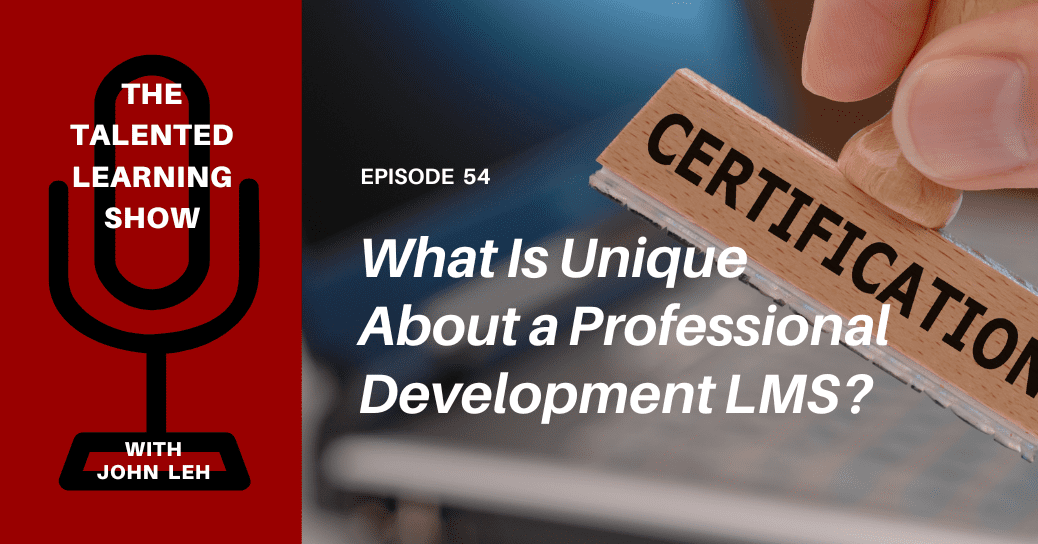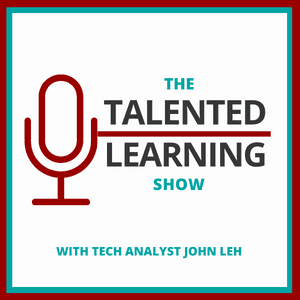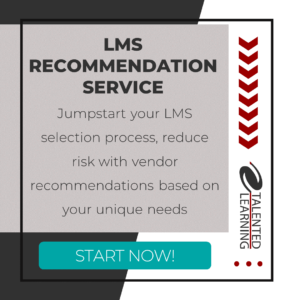
Podcast: Play in new window | Download
Subscribe: Apple Podcasts | Spotify | Amazon Music | Android | iHeartRadio | Blubrry | Email | RSS
EPISODE 54: WHAT TO EXPECT IN A PROFESSIONAL DEVELOPMENT LMS

Phil Vervaet, VP, Crowd Wisdom LMS
If you follow this podcast, you know that learning systems come in a variety of flavors. But what exactly distinguishes traditional LMS platforms from professional development systems?
For reliable answers, I’ve invited Phil Vervaet, to share his expertise on this episode of The Talented Learning Show. Phil is Vice President of Sales Enablement for Crowd Wisdom LMS by Community Brands. He recently transitioned into this role after 10 years in senior operations and account management positions at Community Brands.
Phil also has significant experience in technology consulting roles that round out his perspective. So join us as we look closer at what it takes to support professional development in today’s continuing education landscape…
PROFESSIONAL DEVELOPMENT LMS TRENDS – KEY TAKEAWAYS
- Learning systems designed for professional development are similar to employee LMS platforms in multiple ways. But they also differ in many other respects.
- The distinctions between these types of learning systems aren’t about core functionality, but about how professional development platforms simultaneously support highly personalized learning experiences across many organizations, each with complex requirements and context.
- Innovative functionality is making certification training and exam prep much more effective for individuals as well as professional development providers.
PROFESSIONAL DEVELOPMENT LMS TRENDS – Q&A HIGHLIGHTS
Phil, for those who aren’t familiar with Crowd Wisdom, could you tell us a bit about it?
Sure. Crowd Wisdom is a feature-rich LMS platform focused on supporting professional development programs. It delivers educational content centered around the learner. In other words, we consider an individual’s interests and history, as well as activities that engage their peers. It’s ideal for associations and other organizations that help individuals earn credits for certification through targeted learning activities.
We are owned by Community Brands, a leader in cloud-based software that currently serves more than 13,000 organizations. Our global mission is to help organizations succeed in growing more rapidly and robustly as they fulfill their potential.
A system built for professional development isn’t the same as an employee LMS. What’s the difference?
Professional development systems are designed for organizations where continuing education helps drive revenue. So, along with selling memberships and conferences, selling educational content is the third leg of the stool. That’s where we excel.
How does that work?
First, you need to address an audience of individuals that could be located anywhere in the world.
Also, these people typically participate in continuing education after hours or on weekends — not at work.
Plus, you can’t dictate their technology. You don’t know about their browser, their device or the kind of connection they use. You need to have a very solid system and SLA, so content is always available, anytime and anywhere they need access to it.
You also need the ability to sell content. That comes in two forms:
- B2C: Selling professional development directly to members or consumers, and
- B2B: When one organization sells to another. This is becoming more and more popular.
Want a better way to manage the business of learning? Find vendor profiles, reviews, case studies and more in our free Learning Systems Directory…
Tell me more about the B2B side…
In the healthcare space, say a whole hospital system wants to buy 100 seats for nurses in one hospital. But then they want to make that content available across all five hospitals in their system. So it’s important to be able to expand to, say, 500 seats, 100 for each facility.
So we need to make that happen, including reporting that goes up through the organization. And obviously, the healthcare association that provides the source content wants that data, as well.
Mm-hmm…
And of course, busy professionals are asking, “How is this really relevant to me?” That’s where personalization tools help make professional development programs more learner-centric in terms of building a program that really fits individual needs.
In addition, we’re seeing more and more microlearning – breaking up large blocks of content into very small pieces that learners can consume at their convenience. And it’s sticky as well.
So the healthcare association you mention may try to force an employee LMS to support the needs of different hospitals in a way that’s easy and secure. But that’s when they hit a wall. Let’s talk about that…
Sure. One area involves content authors. Say an association is known for great leadership training. They want to sell it in a B2C context and to other organizations that want to distribute it to their people, as well.
You’ll need support from a structured hierarchy as well as strong personalization. It’s like having a slice of a co-branded LMS so it meets any organization’s branding needs, but it’s also brought to you by these specialty content folks. So everyone could have their own little branded piece of the LMS.
Right…
And then how do you structure it? The complexity is really on the data reporting side. For example, if I’m a line manager, I should see data only for the people who report directly to me, while my boss should be able to see downstream and upstream data. This way, content can be personalized, and organizations know which learners are starting it, completing it, and getting results from those learning experiences.
Makes sense. What else?
Some associations have program directors that want to send assignments to specific groups. For example, in healthcare, a program director at an association like the American College of Emergency Physicians (ACEP) may want to share an assignment with students at various med schools.
For example, I may want to create a pop quiz with 10 questions I’ve pulled from a central bank of questions. I can assign that to specific groups of students and track their engagement behavior and results. And I can bring in more people to improve control at various levels, so the organization can track and better understand what their learners are doing.
Find out how real-world companies are achieving more with learning systems that create business value. Get inspiration from dozens of success stories in our free LMS Case Study Directory…
Interesting. What’s different is you can manage the structure and content for 1000 organizations, simultaneously. That’s where the complexity comes in. It’s about all these things working together at the same time for multiple business relationships.
Yes. Currently, internal training is focused on development. People want to build new knowledge and skills. And companies want to help staff grow because the market for talent is so competitive. Associations can offer professional development as a valuable way to help employers attract and retain people.
I’m also seeing a lot happening with test preparation. Could you tell us more about that?
Absolutely. Many of our clients are advancing in the area of exam prep because it can be a big revenue driver. And one of our differentiators is our ability to add a layer to our assessment engine so it supports exam prep.
So let’s say you want to be a certified treasury professional. If you have access to a pre-assessment, you can understand your strengths and weaknesses.
Some organizations structure exam prep around competencies or topics. Others build the content into chapters. But then you can tag all the questions throughout the system.
Then you have the flexibility to request questions for a specific time interval (say, if you have 15 minutes available). And you can request questions from specific content pools where you need to focus. The system can randomize question stems and distractors, and then feed you relevant questions.
The exam experience will vary each time you run an exam prep scenario. But it feeds you relevant questions so you can test your knowledge whenever you have time to focus. Plus it gives you confidence levels.
What does that mean?
Let’s say you answer a multiple-choice question correctly. Were you guessing or did you really know the answer? When you’re in exam study mode, you can configure settings that will give you immediate feedback about why your answer is correct or not. And you can get access to information sources and related learning activities. Plus, you rank your confidence in your answer.
How would that work?
Here’s an excellent use case from an association of operating room nurses, AORN. They want to be sure their nurses score 100% correct, with a 100% confidence level. That’s the only situation when a nurse can earn credit. So clearly, they want these nurses to know their stuff.
I hope so…
So these nurses can set up a mock exam based on those rules. For some groups, it’s a four-hour exam with multiple sections. And for each section, you can set a “soft timer” that will tell you how long it actually took to finish. In other words, if you need 120 minutes to complete a section that should take only 90 minutes, the soft timer will let you know. However, it won’t cut you off. This keeps you aware of your performance so you can speed up your practice and learn more effectively over time.
Cool.
All of these features ensure that test prep participants really know their stuff. They can set up mock exams that are based on their group’s actual testing standards. So they get better test results and also are better prepared for their professional roles.
Good point. So, what is the biggest technical or integration challenge you see with organizations that provide professional development…?
…FOR COMPLETE ANSWERS TO THIS AND MORE QUESTIONS ABOUT LMS INNOVATION, LISTEN TO THE FULL 30-MINUTE PODCAST!
Need Help Finding the Best Training Content Business LMS?
Fill out the form below to request a complimentary consultation call with John Leh:





